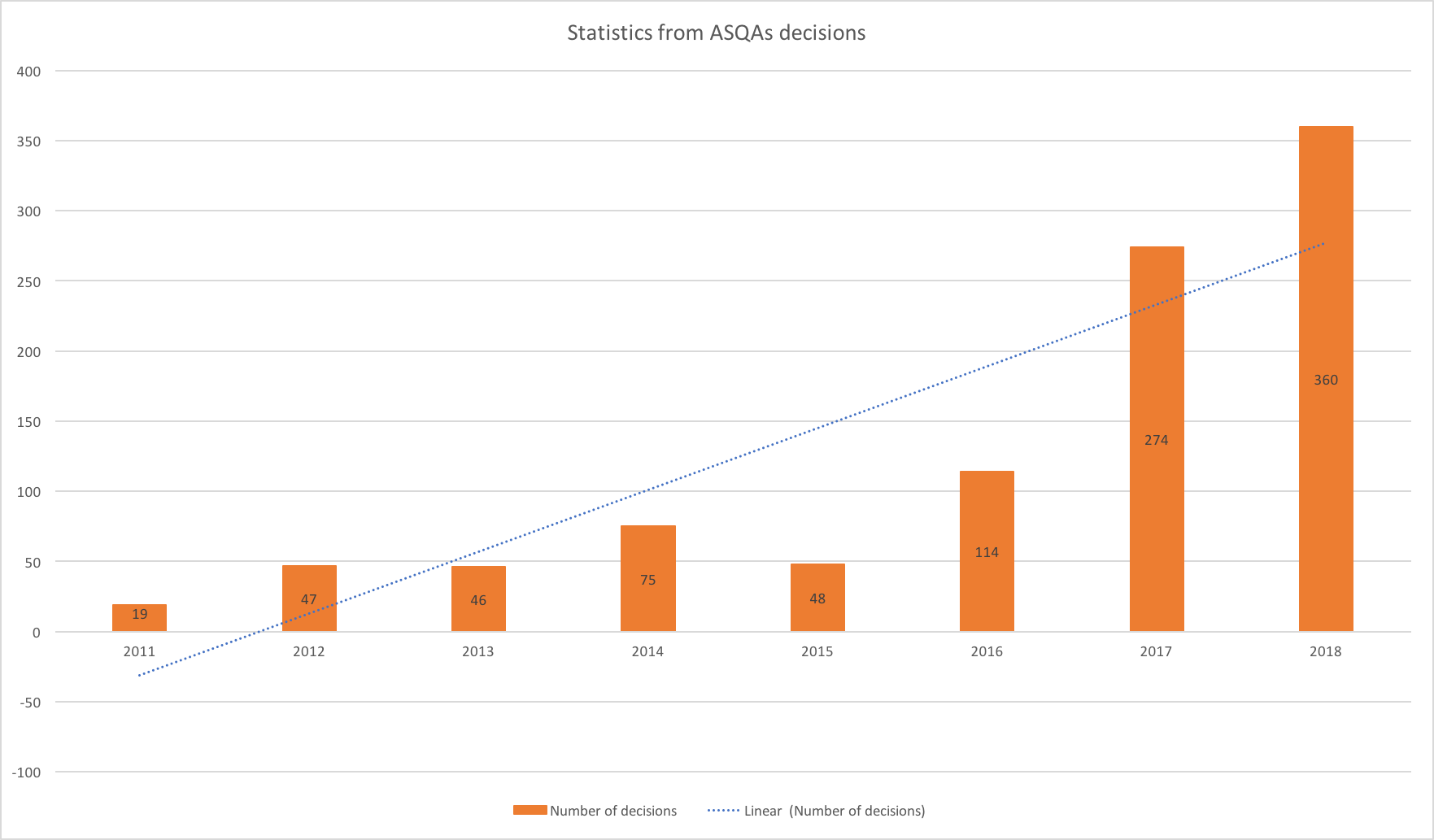We have just received a new list (published on 2 January) showing 11 RTOs that have had their registration cancelled by ASQA. This means that during 2018 the regulator decided to either cancel registrations or apply sanctions to 367 RTOs, which represents the worse performance record for the VET sector, ever.
The number of RTOs that demonstrate compliance at the time of audit continues to be marginal, and has not reached 30% since ASQA was established in 2011. Add to this, the number of RTOs that successfully rectified non-compliances after the audit has been declining since 2014. This situation suggests that the problem goes beyond any issues associated with implementing strategies, but instead the problem is in the design of the strategies and plans.
I am not sure that ASQA’s compliance report is a true reflection of the performance of RTOs; I suspect it is a reflection of other issues within the system, but that is a topic for another article.
The reality is that RTOs must live in the current compliance regime and, therefore, it is important to analyse the triggers for such a negative result. According to ASQA, the three main areas that contributed to non-compliances were:
- Amount of training
- Assessment practices, and
- Managing third parties.
 In this article, I will focus on the amount of training, which is definitely an issue. Generally, the problem is lack of training; extremely short courses that do not provide time for students to assimilate the knowledge, and develop the skills to competently perform the required tasks under relevant workplace conditions.
In this article, I will focus on the amount of training, which is definitely an issue. Generally, the problem is lack of training; extremely short courses that do not provide time for students to assimilate the knowledge, and develop the skills to competently perform the required tasks under relevant workplace conditions.
I agree that competencies are the measure of success in vocational education and not the time required to get there. But learning is a journey that takes time, and time is an important factor to consider simply because individuals don’t learn by osmosis, individuals need to work through learning activities over time. The type of activities and the time required will vary depending on the previous skills, knowledge and experience of the learner.
From a more strategic point of view, this means training providers need to plan these learning activities, including access to the resources required, and ensure they are relevant to the needs of students’ cohorts. This is all that is needed to be compliant!
During the design stage of your course, you must identify how much time your students will need to absorb the knowledge and develop the skills included in the course. If you have different students’ cohorts, you will have different strategies with different durations. As the course is implemented, there may be some variations to your initial estimated duration, due to some students completing activities at a faster pace than others, but these variations can be easily documented.
You need to establish the most suitable delivery sequence, contemplate the appropriate delivery mode, media and resources. In other words, you are required to describe in detail the students’ learning journey (including the duration of this journey), and explain why that journey is appropriate to your students’ cohort.
The above must be reflected in the Training and Assessment Strategy (TAS), not as a report for ASQA’s auditor, but as an action plan for the provider.
The TAS is the action plan for the delivery of the course, a documented guide to deliver and assess your course. The TAS will be used by:
- Financial controllers to ensure the financial viability of the course (according to the business plan)
- Management to purchase required resources (learning, assessment, equipment, facilities)
- HR to contract the required trainers and assessors
- Marketing staff to identify the features of the training product and relevant marketing strategies
- Academic staff to guide their delivery and assessment activities (session plans, assessment plans, tools); and
- ASQA’s auditors to assess the suitability of your planned amount of training, considering the complexity of your course and the previous skills, knowledge and experience of your students’ cohort.
Finally, from the evaluation and quality control point of view, the provider must monitor the implementation of the TAS, (records of students’ attendance to learning activities, resources used, completed tasks, etc.) must demonstrate an effective implementation of the TAS. Such evaluations will provide data for future improvements and potential changes to the original TAS.
What ASQA is finding in its regulatory work is:
- Lack of information in the TAS (i.e. the TAS states that students will spend 450 hours online, but no information provided about what are the online learning activities to be performed, or not defining the students’ cohort). Therefore, the provider failed to demonstrate due consideration to the students’ learning journey (including the amount of training)
- Information presented in the providers’ TAS is not consistent with the course requirements and students’ needs (i.e. not clear how an individual with no previous skills, knowledge, or experience as a trainer can obtain a TAE40116 Certificate IV in Training and Assessment within two months), and
- Evidence of implementation inconsistent with TAS (i.e. TAS states a duration of six months but students’ records demonstrate that most students complete the course within six weeks).
Some cases are clearly a recipe for being non-compliant, and ASQA is targeting these “high risk” scenarios. For example, a typical Diploma of Business course that is delivered to international students during one year (40 tuition weeks, 800 hours) had an average cost of $5,000 (source: myskills). Agents charged students an average commission of 25% (some are charging 30%), which means the provider receives $3,750 per student.
Let’s do some calculations.
The average salary of a business trainer is $45 per hour. If the provider opens a class of 25 students, it will collect $93,750, of which $36,000 (800 hours times $45) will be paid to the trainer (not considering superannuation and other entitlements).
The average cost of a venue in Sydney is $1,000 per square metre. To accommodate 25 students and a trainer the room should have at least 45 square metres. That represents a cost of $45,000 per year. The provider may use the classroom for three different shifts and, therefore, we can split this cost by three classes.
From the $36,000 we have left (after paying the trainer), we need now to pay another $15,000 for the classroom, which means the provider will have $21,000 left to pay for all other overheads during one year (electricity, internet, paper, software, quality control, admin staff, cleaning, etc.) and to purchase or develop quality learning and assessment resources for 25 students.
Is the above example viable?
This is only one example from the CRICOS sector, but the lack of consideration to resources required to support the students’ journey (amount of training), affects providers for local students as well.
I agree that regulating the amount of training is a reactive measure against poor training and assessment. But it is an attempt to neutralise and eradicate the culture of excessively short courses from our system. A culture that has contributed to devaluing VET, to the point that some employers and students perceive VET courses as a quick update of information about a task or a job, and are not prepared to dedicate enough time to a VET course.
Start with your business plan and ask yourself: is my training product viable considering the current market conditions? If so, make sure you have duly considered the learning journey (including the amount of training), has a suitable strategy been developed for the learning journey, is this sufficiently documented in your TAS, and are you continuously receiving and analysing data after implementing your strategy to confirm compliance with you own TAS.
If the training product is not viable, sooner or later ASQA will find your RTO non-compliant.





